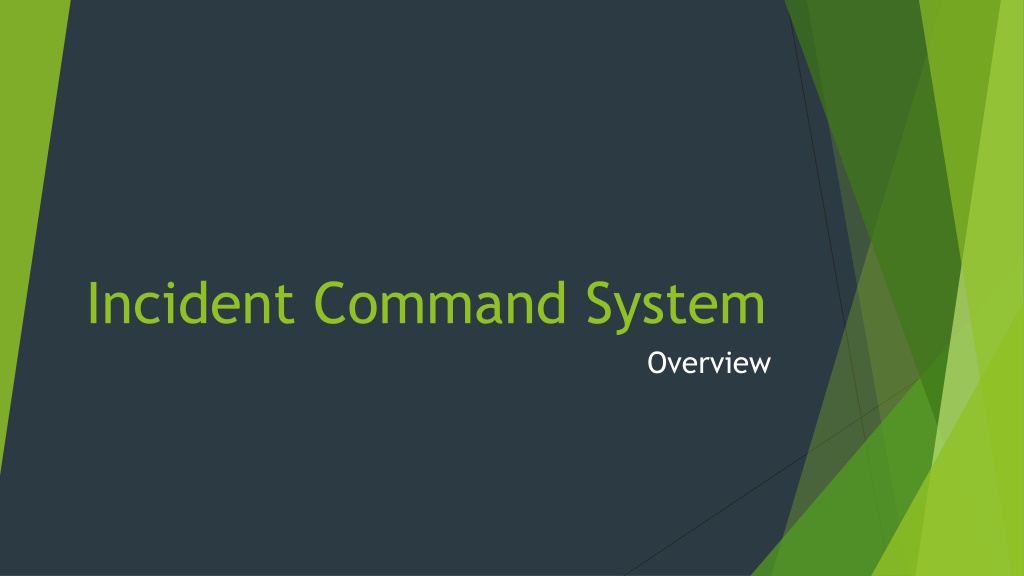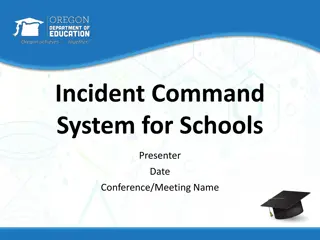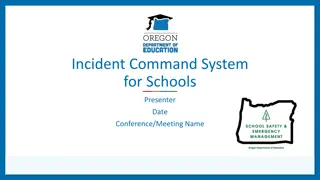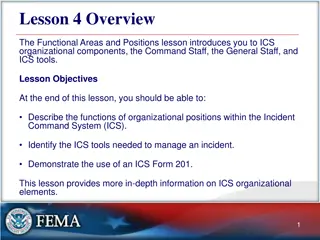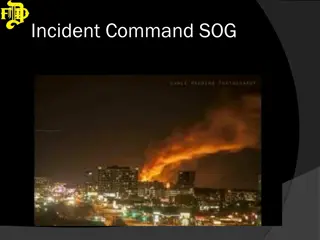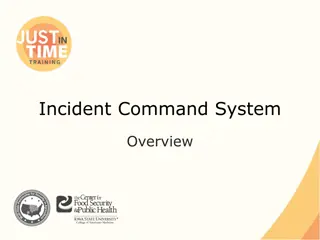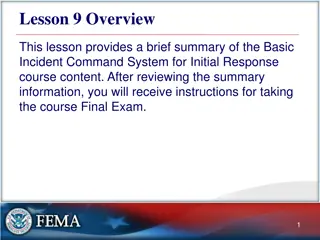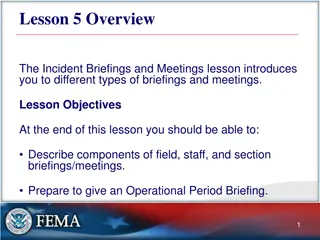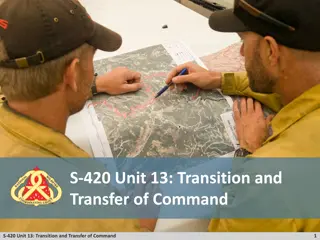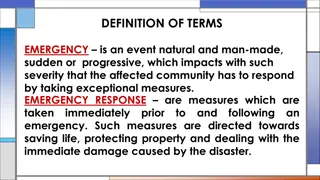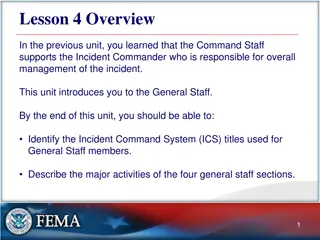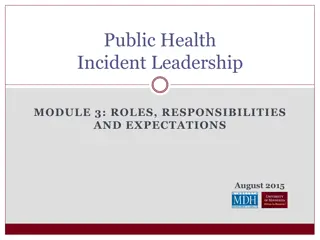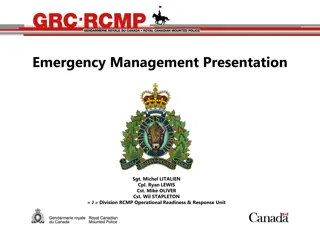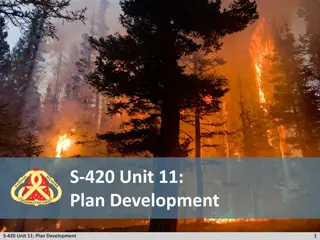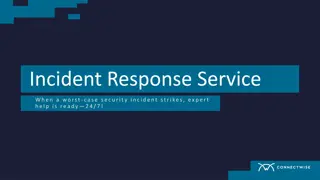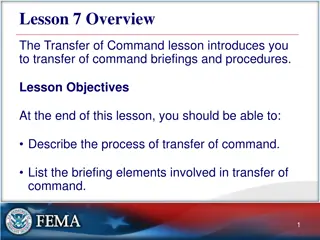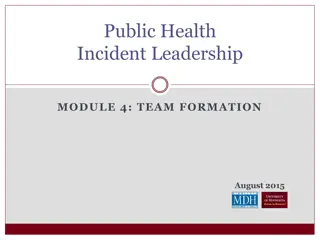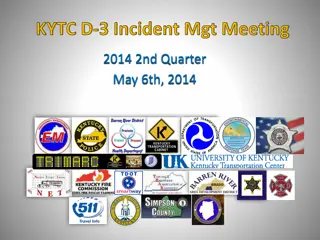Overview of Incident Command System (ICS) for Emergency Response
The Incident Command System (ICS) is a model designed for effective command, control, and coordination of emergency responses at various levels. It provides a structured framework for managing incidents, ensuring unified command, setting objectives, managing resources efficiently, and maintaining clear communication. ICS organizes personnel into specific roles and responsibilities, such as Command Staff Positions, for effective incident management. Key principles of ICS include single/unified command, management by objectives, comprehensive resource management, unity of command, and integrated communications. The ICS structure can be applied not only at the site level but also at Emergency Operations Centers or other support activities at different levels.
Download Presentation

Please find below an Image/Link to download the presentation.
The content on the website is provided AS IS for your information and personal use only. It may not be sold, licensed, or shared on other websites without obtaining consent from the author. Download presentation by click this link. If you encounter any issues during the download, it is possible that the publisher has removed the file from their server.
E N D
Presentation Transcript
Incident Command System Overview
What is the Incident Command System? The Incident Command System (ICS) is a model for command, control, and coordination of emergency response at the site level. The same ICS structure can also be used to coordinate site support activity at an Emergency Operations Centre or regional/provincial support activity, or federal support activity.
ICS Principles 1. Five Primary Functions 2. Establishing and Transferring of Command 3. Single or Unified Command Structure 4. Management by Objectives 5. Consolidated Incident Action Plans 6. Comprehensive Resource Management 7. Unity and Chain of Command 8. Manageable Span of Control 9. Modular Organization 10. Personnel Accountability 11. Common Terminology 12. Integrated Communications
Command Sets objectives and priorities Responsible for all incident or even activity There will always be an Incident Commander (IC)
ICS Organization Command Information Safety Liaison Finance and Administration Operations Logistics Planning Staging Area Support Branch Resource Unit Time Unit Branches Procurement Unit Special Operations Supply Unit Situation Unit Divisions / Groups Facilities Unit Compensation/ Claims Unit Documentation Unit Strike Teams Ground Support Unit Demobilization Unit Cost Unit Task Forces Services Branch Technical Specialists Single Resources Communications Unit Medical Unit Food Unit
Command Staff Positions Information Officer One per incident who serves as a central point for information dissemination Safety Officer Anticipates, detects, and corrects unsafe situations Command Liaison Officer Contact point for representatives of assisting and cooperating agencies Information Safety Liaison Finance and Administration Operations Logistics Planning Staging Area Support Branch Resource Unit Time Unit Branches Procurement Unit Special Operations Supply Unit Situation Unit Divisions / Groups Facilities Unit Compensation/ Claims Unit Documentation Unit Strike Teams Ground Support Unit Demobilization Unit Cost Unit Task Forces Services Branch Technical Specialists Single Resources Communications Unit Medical Unit Food Unit
Operations Conducts tactical operations Operations Staging Area Develops the tactical objectives and organization Branches Special Operations Divisions and/or Groups Strike Teams Directs all Resources Task Forces Command Information Single Resources Safety Liaison Finance and Administration Operations Logistics Planning Staging Area Support Branch Resource Unit Time Unit Branches Procurement Unit Special Operations Supply Unit Situation Unit Divisions / Groups Facilities Unit Compensation/ Claims Unit Documentation Unit Strike Teams Ground Support Unit Demobilization Unit Cost Unit Task Forces Services Branch Technical Specialists Single Resources Communications Unit Medical Unit Food Unit
Planning Collects, evaluates, and displays incident information Planning Resource Unit Maintains status of resources Situation Unit Documentation Unit Prepares Incident Action Plan (IAP) Demobilization Unit Technical Specialists Command Information Prepares other incident related documentation Safety Liaison Finance and Administration Operations Logistics Planning Staging Area Support Branch Resource Unit Time Unit Branches Procurement Unit Special Operations Supply Unit Situation Unit Divisions / Groups Facilities Unit Compensation/ Claims Unit Documentation Unit Strike Teams Ground Support Unit Demobilization Unit Cost Unit Task Forces Services Branch Technical Specialists Single Resources Communications Unit Medical Unit Food Unit
Logistics Provides services and support to meet the incident or event s needs Logistics Support Branch Supply Unit Facilities Unit Ground Support Unit Provides resources Services Branch Communications Unit Provides other services Medical Unit Command Food Unit Information Safety Liaison Finance and Administration Operations Logistics Planning Staging Area Support Branch Resource Unit Time Unit Branches Procurement Unit Special Operations Supply Unit Situation Unit Divisions / Groups Facilities Unit Compensation/ Claims Unit Documentation Unit Strike Teams Ground Support Unit Demobilization Unit Cost Unit Task Forces Services Branch Technical Specialists Single Resources Communications Unit Medical Unit Food Unit
Finance/Administration Keeps track of incident related expenses Finance and Administration Time Unit Equipment records Procurement Unit procurement contracts Compensation/ Claims Unit Cost Unit other financial related expenses of the incident Command Information Safety Liaison Finance and Administration Operations Logistics Planning Monitors costs Staging Area Support Branch Resource Unit Time Unit Branches Procurement Unit Special Operations Supply Unit Situation Unit Divisions / Groups Facilities Unit Compensation/ Claims Unit Documentation Unit Strike Teams Ground Support Unit Demobilization Unit Cost Unit Task Forces Services Branch Technical Specialists Single Resources Communications Unit Medical Unit Food Unit
Five Primary ICS Management Functions Command Finance and Administration Operations Planning Logistics
ICS Response Functions Command The Boss Operations The Do-ers Planning The Thinkers Logistics The Getters Finance/ The Payers Administration
ICS Response Goals Provide for safety and health of all responders Save lives Reduce suffering Protect public health Protect government infrastructure Protect property Protect the environment Reduce economic and social losses 1. 2. 3. 4. 5. 6. 7. 8.
Incident Command Post (ICP) Temporary locations for resources awaiting assignments Resources on a three minute available status May include fueling and sanitation Staging Area Manager is required May be designated for certain kinds of resources
Staging Areas Temporary locations for resources awaiting assignments Resources on a three minute available status May include fueling and sanitation Staging Area Manager is required May be designated for certain kinds of resources S
Summary Think ICS even at the simplest of incidents. If you think of the 5 functions Command Operations Planning Logistics Finance/Administration at the start of an incident, the transition from a small operation to a major event will be much easier.
Summary ICS requires only one position filled - that of the Incident Commander (IC). The IC fulfills all of the functional responsibilities (boxes) until responsibility for a particular function is assigned to another person. Each function (box) is filled only if and when necessary. Think functions not people!
Want to Know More? Phone: 604 528 5649 Fax: 604 528 5798 www.jibc.ca/emergency
